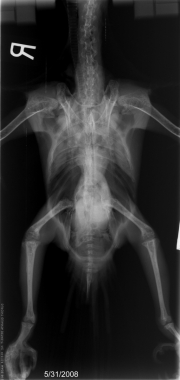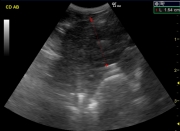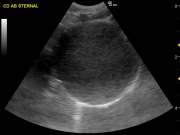This week we have an avian case contributed by Dr. Leila Marcucci of the Bay Area Bird Hospital in San Francisco. It’s a 21-year-old female Scarlet Macaw who presented for increased water intake, watery droppings, and decreased appetite. Have a look and post your comments below.
Case originally posted on November 27, 2008






The vertebras and the areas of the femoral head and humeral head seem a more radiolucent than what I would expect, but on the other hand I haven’t seen many rads of Macaws…
Hi there!
There is a rounded, well defined, soft tissue opaque mass in the caudal coelom, superimposed to the pelvic limbs. I think the hepatic silhouette is decreased in size. There a heterogeneous increased opacity within the medulary cavities of the femur and tibiotarsus, bilaterally. My first differential for that is polyostotic hyperostosis with a non-calcified egg. The possibility of a coelomic neoplasia such as oviductal tumor also needs to be considered.
Have an excellent Thanksgiving!!
Hi there,
as a therapy they performed a salpingohysterectomy. Why didn’t they removed the ovarium. What happens with the next ege. It will fall in the abdomen cavity and caused an ege-peritonitis?
Sam, here’s the response from Dr. Marucci:
A salpyngohysterectomy does not include removal of the ovaries – they are intimately associated with the aorta and attempted surgical removal has a high risk of severe hemorrhage.
The concern is that follicles will mature and drop into the coelomic cavity, possibly causing an egg yolk coelomitis. This is a valid concern and is a side effect we often see. It is possible for birds to drop an active follicle and not generate an infection or only develop a mild self-limiting infection. In this bird’s case, she has a history of only 1 egg being produced previously. She has had a single incident of egg yolk coelomitis in the past (with her reproductive tract intact!). Therefore, she has a much lower risk of egg yolk coelomitis than some birds.